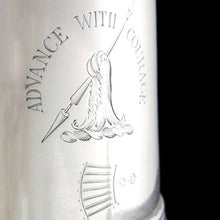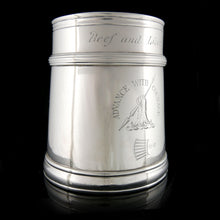Beefsteak Club Mug, 1800
Adding product to your cart
Height: 10.3cm (4in)
Provenance: Sotheby’s, New York, 20 May 2004
Bengal silver. Tapering body with banding and scroll handle, the front inscribed ‘Beef and Liberty’ and engraved with a gridiron, and the crest and motto of the Marjoribanks family. Maker’s mark of Mair & Robertson, Calcutta circa 1800.
Read more

The present mug was made by the same firm of Calcutta silversmiths that struck the East India Company medals for the Mysore campaign. The mug was possibly made for Charles Albany Marjoribanks (1794-1833), the East India Company official who for seventeen years conducted himself with ‘much celebrity’ during his time as the supervisor of the company’s commerce with China. During this period the East India Company held a century-old monopoly over the China trade which included the importation of opium leading to the eventual outbreak of the Opium War of 1839-1842. In 1832, defying both the EIC’s longstanding pacific China policy and Qing law, Marjoribanks, sent a secret mission to the forbidden coast of the Middle Kingdom ‘to ascertain how far the northern ports … may be gradually opened to British commerce.’ The voyagers loaded a private ship, Lord Amherst, with English products, disguised themselves, landed in several forbidden ports, distributed Chinese tracts about ‘the English character’ and religion, and clashed with the Qing authorities trying to drive them away. Majoribanks afterwards turned to politics, having become a freeman of the city of Edinburgh in 1824. At the 1832 general election he became the Liberal Member of Parliament for Berwickshire, and accordingly helped pass the Great Reform Bill of that year. He died just one year later at the age of 39 and, marked out as ‘a man of high talents’, is commemorated by the Marjoribanks monument in Coldstream. According to the The Signet Library website a digitized version of his ‘astonishingly indiscreet and darkly entertaining memoir of his life and travails in Scotland and the East’ is shortly to be available.
Beefsteak Club is the generic name of several 18th and 19th-century dining clubs that celebrated the beefsteak as a symbol of patriotic and often Whig concepts of liberty and prosperity. The first beefsteak club was founded about 1705 in London by the actor Richard Estcourt (1668-1712) and others in the arts and politics, but it only existed for a decade or so. A typical dinner might consist of a beefsteak, followed by toasted cheese and Port. Other Beefsteak Clubs were formed mid century. Many used the gridiron as their symbol, and some are even named after it, including the Oxford Gridiron Club (est.1884) and the Gridiron Club of Washington, D.C. (est. 1876) that became essential after-theatre club for the bohemian set.








